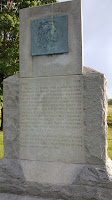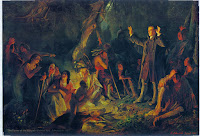When thinking about women who played important roles in the American Revolution, I’ll bet a Native American warrior woman doesn’t spring to mind. But today we’re going to take a look at a female Shawnee chief and warrior who, surprisingly, played an important role on the side of the Americans in opposition to the majority of her people. Nonhelema will appear in book 6 of my American Patriot Series,
Refiner’s Fire, bringing a warning of danger to Jonathan Carleton/White Eagle as she did in real life to American soldiers on the frontier during the Revolution.
 |
Nonhelema's Memorial Stone
Logan Elm Park |
Nonhelema was born around 1718, about 2 years before her most famous brother,
Cornstalk. They had 2 younger brothers, Silverheels, and Nimwha. The family migrated to Pennsylvania from West Virginia or Maryland around 1730 as the Shawnee and other tribes were increasingly pushed westward by the expansion of white settlements into the continent’s interior. From there they relocated to Ohio Territory near present day Chillicothe on the Scioto River.
According to the journal of Indian agent
George Morgan, their father was named White Fish, and Cornstalk seemed to confirm that in a 1775 speech. However, according to the records of the Moravian missionaries, Cornstalk was the son or grandson of a well-known Pennsylvania Shawnee chief named Paxinosa, or “Hard Striker”, who has been mistakenly identified by some writers as Tecumseh’s father. I’ve found some accounts online that link the two names, so both may be correct. Nonhelema first married an unnamed Shawnee man, and later in life married the Shawnee chief Moluntha. She had several children, including a son, Thomas McKee, from her relationship with Indian Agent Colonel
Alexander McKee and another son, Captain Butler/Tamanatha, with Colonel
Richard Butler.
Nonhelema stood nearly six feet, six inches tall and by all accounts was an imposing figure with a well-formed body and long, flowing hair that turned white in old age. When she was young she fought as a warrior and was known to be a fierce adversary in battle. She came to be called The Grenadier or Grenadier Squaw in reference to the height of 18th-century grenadiers. She was present at the
Battle of Bushy Run in August 1763 and may have participated in it, painting her body black and fighting naked as was the custom of her people. Without a doubt the sight of such a warrior must have given her enemies pause!
 |
Logan Memorial
Logan Elm Park, Ohio |
The Shawnee had both male and female chiefs, and Nonhelema became chief of the largest Shawnee village on the Pickaway Plains in Ohio Territory. Her town lay on the south bank of Scippo Creek southeast of present-day Circleville, a short distance from Cornstalk’s Town on the creek’s north bank. The cabin of Nonhelema’s friend
John Logan, a notable Mingo orator and war chief, also lay nearby. The unprovoked slaying of his entire family by Virginians at Yellow Creek precipitated Lord Dunmore’s War.
Nonhelema reputedly fought at the
Battle of Point Pleasant in 1774, where the Shawnee force led by Cornstalk was defeated and the war essentially ended. Since Shawnee women played important roles in relations with other nations, she most likely attended the treaty with Cornstalk. The place where the treaty was signed and where Logan made his famous lament for his murdered relatives was less than 4 miles from Nonhelema’s Town. She and Cornstalk abided by this treaty for the rest of their lives, unlike the majority of the Shawnee.
Nonhelema’s participation in colonial frontier wars apparently convinced her that the survival of her people depended on living peacefully with the Americans. By the Revolution Nonhelema had become a peace chief, and she spent the rest of her life working toward that end. However, hers and Cornstalk’s peace proposals were opposed by a large faction of the Shawnee, who hoped to use an alliance with the British to reclaim the lands taken from them by settlers. By the winter of 1776, the nation was divided between those who advocated neutrality in the war between the Americans and the British, led by Nonhelema and Cornstalk, and those who allied with the British, led by men such as Black Fish and Blue Jacket, who will also appear in
Refiner’s Fire.
 |
The Power of the Gospel
David Zeisberger preaching to the Indians |
In researching 18th century Native Americans, there are many contradictory accounts and dates that make it difficult to sift out the facts. What is clear, though, is that Paxinosa’s family was greatly affected by the ministry of the Moravians, whose missionaries initially served among the Indians in Pennsylvania, primarily among the Lenape, or Delaware. They eventually established a number of towns for Indian believers along the Muskingum and Tuscarawas rivers in Ohio where many Shawnee towns were located as well. According to
The History of the Moravian Mission Among the Indians in North America, Paxinosa’s wife—who would be the mother of Nonhelema and Cornstalk—was converted by the preaching of the Moravians in 1755 and, with Paxinosa’s consent, was baptized by Bishop Spangenberg. The History also recounts that in 1771 the well-known missionary David Zeisberger traveled among the Shawnee and at the first village was kindly received by a son of the chief Paxnous (Paxinosa)—quite possibly Cornstalk—who offered to accompany them during their visit.

Some online accounts claim that Nonhelema was baptized in 1772 by Zeisberger and took the English name Katherine, with the nickname of Katy. This is quite plausible given the many connections between her family and the Moravians. The History records that in 1776 Cornstalk arrived at Gnadenhütten, one of the towns of the Indian believers, with more than 100 men, women, and children in his retinue, and that “His behaviour was courteous, and he shewed a particular friendship for the missionary Jacob Schmick.” Judging from the actions of Nonhelema and Cornstalk during the American Revolution in working for peace between the Americans and the native peoples, both were deeply influenced by the Moravian doctrine of nonresistance.
On July 25, 1777, Nonhelema warned the soldiers at Fort Randolph on Point Pleasant that most of the Shawnee were allying with the British and planned to attack other forts. Cornstalk came to Fort Randolph with another chief, Red Hawk, that November to warn the fort’s commander that he could not hold his warriors back from going to war against the Americans. The commander held the men as a hostages to ensure the Shawnee’s neutrality, and when Cornstalk’s son came to visit him, he was also held. On November 10, 2 American militiamen from the fort who had gone out to hunt were found killed by Indians. The enraged soldiers broke into the room where Cornstalk and his companions were being held and brutally murdered them in retaliation.
 |
| Fort Randolph |
Nonhelema, who was also at the fort serving as interpreter, had been sent out with 2 scouts as spies to the waiting Shawnee war party to deliver a message from Captain McKee, that he could not comply with their demand to release the chiefs. She most likely was on her way with the message when her brother, nephew, and their companions were killed.
In spite of her brother’s murder, Nonhelema did not waver in her friendship for the Americans. In 1778 she again warned Fort Randolph of a coming attack. On May 20 a Wyandot and Mingo force under Dunquat, the Wyandot Half King, surrounded the fort and began a week-long siege, during which Nonhelema’s large herd of cattle and horses was destroyed. Unsuccessful in their effort to force the fort’s defenders to surrender, the Indians began to move up the Kanawha River to attack Fort Donnally. Nonhelema dressed 2 messengers, John Pryor and Philip Hammond, as Indians so they could carry a warning160 miles to the garrison at Fort Donnally, which then also withstood attack.
 |
Present-day view at site of
Nonhelema's Town |
With her herds gone and her people’s hostility toward her growing, Nonhelema was forced to flee for protection to the town of the Lenape’s principal chief, White Eyes, near the Lenape capital of Coshocton, Ohio. In 1780 Nonhelema served as guide and translator for the U.S. inspector general of cavalry, when he traveled to Illinois to treat with the Indians there. She petitioned Congress in 1785 for a 1,000-acre grant in Ohio, as compensation for her services during the Revolution. Congress denied this claim but granted her a pension of daily rations and an annual allotment of blankets and clothing. When General Benjamin Logan led Kentucky militia against the Ohio Shawnee the following year, Nonhelema and her husband and family surrendered to the troops. Even so, a soldier killed Moluntha, and Nonhelema was held at Fort Pitt. While there she helped the commander compile a Shawnee-language dictionary. She died sometime after her release in December 1786.
 |
| Historical Marker at Nonhelema's Town |
Although Nonhelema was revered by many of the Shawnee as an influential chief, those of her people who allied with the British considered her a traitor. According to Nonhelema’s memorial plaque in Logan’s Elm Park south of Circleville, Ohio, “She spoke three languages, serving as peacemaker and interpreter between Indians and Whites. Because of her friendships, she accepted Christianity. After the peace treaty in 1774, she was disowned by her people and became a homeless exile.”
Nonhelema’s story includes many difficult and sad circumstances, but she was a great leader among her people at a critical time in their history and ours.





